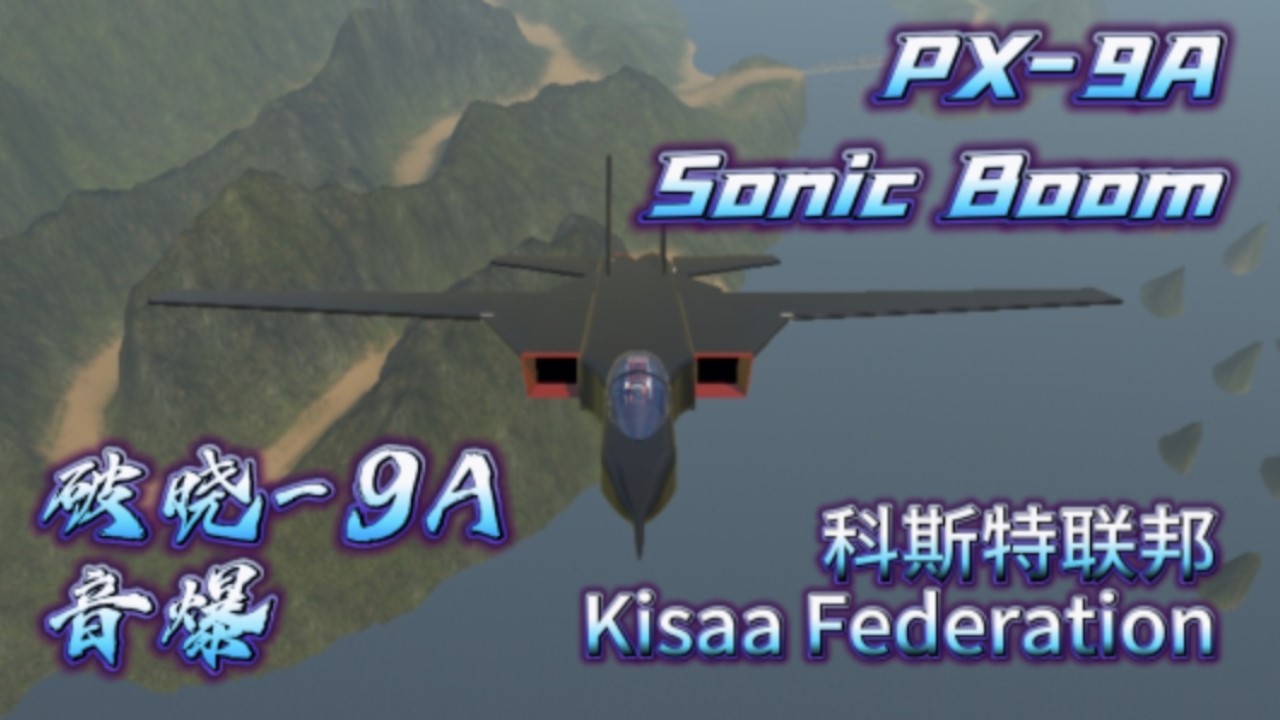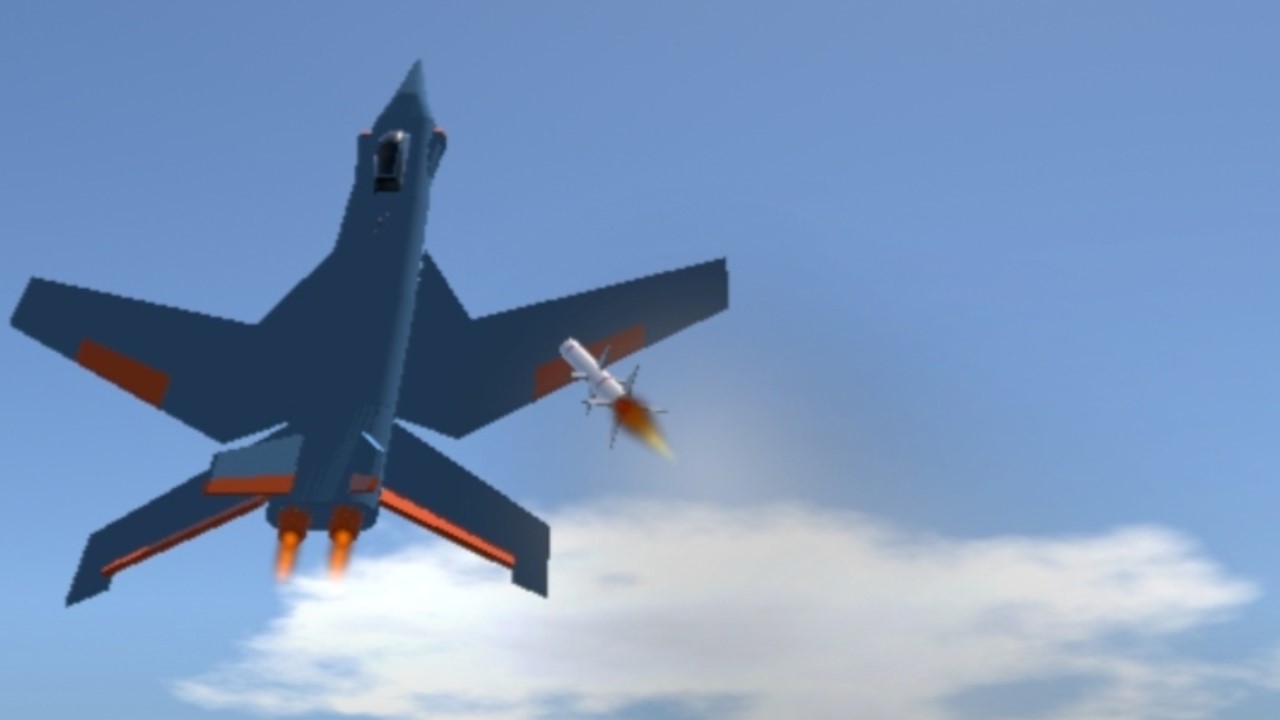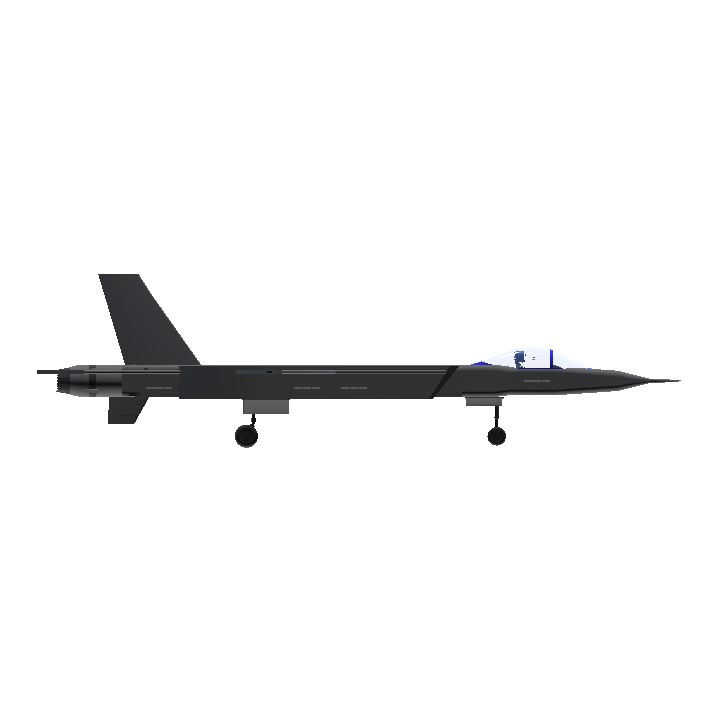In 155, during the war crisis between the Kisaa Federation and the Republic of Skira, in addition to the confrontation between the army on the border, fighter jets were also on patrol in the air. Both air forces are well prepared, and although the Federal Air Force is not as good as the Republic Air Force, they have still drawn up combat plans. Due to the excellent high-speed performance of the PX series fighter jets, the Federal Air Force needs to utilize high-speed performance after thorough investigation and preparation, to first bomb and paralyze the Republic's border airports, reduce the gap between the two sides in a short period of time, and then quickly expand its advantages. However, due to the lack of readily available weapons at the time, pilots had to mount free fall bombs to bomb heavily guarded airports. This plan is not much different from the Republic's plan to throw hydrogen bombs in terms of danger. After the crisis was resolved, the federal leadership voted that there was no possibility of another conflict with the Republic within ten years, and there was a high probability that there would be no conflict within fifteen years. Therefore, from the successful test launch of the LF-1 supersonic missile at the end of 155 to the end (failure) of the TJ-1 cruise missile project in 160, the federal government has been promoting significant breakthroughs in air force infrastructure, including research in materials science and aerodynamics. The development and accumulation of experience over these five years laid the foundation for the Federal Air Force's ability to confront the Republic Air Force head-on in 172
Then, just as they were happy about it, they realized an awkward fact - there was no suitable plane. I have developed this high-tech weapon, can't you still use the old PX-3? So I have weapons and cannot use them. If the Republic suddenly launches an attack, how can we safeguard the freedom and rights of federal citizens in this situation? Therefore, in 161, they quickly pulled up the Dawn Design Bureau, which had been placed for five years, and began discussions on this matter.
The foundation of the Air Force is developing, and the Dawn Design Bureau hasn't had much work in five years. The design bureau can only rely on basic funds to make a living, and how to live in the future is a problem. Therefore, when the federal leadership requested the design bureau, the Dawn Design Bureau quickly packed up their luggage and rushed there. After they rushed over and asked about the design requirements, they realized that the federal authorities had brought them over just to discuss what kind of aircraft to design.
The foundation of the Federal Air Force is far inferior to that of the Republic Air Force, and even the vector engine that has long been popular in the Republic Air Force was developed by the Surge Power Company in 155. But they were not without merit. The unique afterburner engine of the PX-3 multi-purpose fighter jet was the only one that existed at that time, making it the world's first aircraft to break through Mach 2. Therefore, the Republic's main fighter jets value maneuverability, while the Federal main fighter jets value high-speed. So, after multiple rounds of voting, the design bureau proposed an idea - to build two types of fighter jets, one inheriting the bloodline of interceptors and focusing on high-speed support; Another type of multifunctional fighter can not only serve as an air superiority fighter, but also as an excellent ground attack aircraft after switching weapons. Although this idea requires the production of two types of fighter jets, it seems to be in line with the current situation of the Federal Air Force. After gritting their teeth, the Black Federation senior management approved this idea.
Therefore, the Federation has simultaneously launched the FF Program (Fast Fighter) and the MF Program (Multifunctional Fighter). The FF plan is today's protagonist, the fastest legend - Breaking Dawn 9A.
In subsequent discussions, they began to define requirements for the plan. As they are not sure how fast the highway needs to be, they first conservatively delineate a possible range. Considering the development of technology, they have decided to achieve a maximum speed of over Mach 3.5 per hour at an altitude of 8000 meters; The maximum flying altitude is 20000 meters. For mobility, they thought for a moment and thought that high-speed fighter jets should not have much mobility demand, so they did not make any requirements... is this requirement conservative? Mach 3.5! The design bureau feels that this is very troublesome. Not to mention whether the pilot can withstand such a high speed, 3.5 Mach is about 4000 km/h. How can we improve it? How about leaving the problem to the surging power company.
So after the request was confirmed, they quickly brought together the relevant companies and military enterprises involved. In addition to the new requirements for materials and anti G clothing, they focused on finding and discussing Pengpai Power Company. The top management of the power company would be foolish to hear the request, what the hell? The CEO even suspects that he may be implicated as a result. If this requirement is not met and the federal executives blame the problem on the power company, it is uncertain how I will be killed by angry federal citizens. But they cannot refuse, they can only guarantee a certain completion of the target first, and then work hard on the bottom designers.
Regardless of how surging power company solves the problem, Dawn Design Bureau will first encounter the problem - how to design the aircraft? After several rounds of discussion, they believed that the wind resistance of the external hanging rack was too large to be conducive to supersonic flight, so they decided to adopt a built-in magazine design. This plan continues the variable sweep wing design of the PX-3; After aerodynamic verification, the upper single wing design is adopted to increase the aircraft's stability and ensure its high-speed performance; The intake ports are located on both sides of the fuselage and adopt a large intake port design to increase the intake volume; The belly of the aircraft adopts a large capacity built-in magazine to increase the payload and leave space for subsequent installation of large weapons; At the same time, increase the fuel tank capacity to ensure sufficient idle time during afterflight. They even adopted dual vertical tail fins and added pelvic fins to ensure heading stability. All sorts of designs point to the characteristic of high-speed flight, which determines her slender body. Although it is not conducive to maneuverability, it provides considerable high-speed performance... and then something goes wrong.
The plane disintegrated. In a virtual simulator, when the flight speed exceeds two Mach per hour, the aircraft experiences severe shaking, followed by disintegration. This incident shook everyone, and without solving this problem, the plan will be difficult to advance. However, after the designer checked the requirements, they did not identify the problem. It was already 163 years ago, and federal officials began urging the Design Bureau to provide solutions. The design bureau is divided into two factions, with one proposing to increase stability by increasing weight. They ultimately doubled the weight of the entire machine and successfully solved the problem; Another faction believes that we should continue to search for the root cause of the problem. Just as the two sides were arguing, the engine was delivered by the surging power company.
Originally, Pengpai Power Company was worried about what to do if the engine test failed. After discovering that the design bureau had not even finished designing the aircraft, they were relieved because they were certain that even if the problem was pursued later, it would only be pursued by the design bureau. The design bureau quickly used this engine on a virtual simulator and found that by doubling its weight, the aircraft would still shake and disintegrate even after reaching higher speeds. In response, the designer who originally proposed increasing the weight readjusted the weight until it doubled before solving the problem. At this point, the speed has reached 4400km/h, and it can be said that the engine problem has been completely solved. The basic design of the aircraft is completed and can be submitted. However, in the maneuverability test, this aircraft had a maximum overload of only 9G without activating the afterburner, far lower than the PX-3 data. Therefore, even after the proposal was submitted, the federal executives furrowed their brows and decided to let them see if they could make any further modifications. At the end of 163, another machine finally discovered the fundamental problem - the connection of the fully moving tail wing was firm. After adjusting the hinge damping, they completely solved the problem. The faction that increased the weight, due to their plan breaking down at a speed exceeding Mach 4 during the aircraft's afterburner dive, is considered flawed. The final problem was completely resolved, and the weight of the fighter remained unchanged.
In 164, with the equipping of anti G suits and new weapons, the basic design of fighter jets was completed. After the prototype left the factory, the test pilot piloted a steel giant with high quality, starting to break through the speed limit in human flight history. 4600... 4700... 4800... 4850... 4900! The new aircraft successfully broke the Mach 4 speed limit, even faster than required! As soon as the news came out, all the people involved in the design were very excited, especially the surging power company, which greatly increased their reputation. They even held a three-day party for it. At the same time, this aircraft can still reach 2000km/h without activating the afterburner, with a maximum overload of 23G at 1200km/h, which is a fundamental leap compared to the original 9G.
Finally, at the end of 164, the federal government decided to purchase the aircraft and named it the PX-9A. As a pure interceptor, she deeply impressed everyone with the speed of Mach 4. In the battlefield, she will serve as support and rush to the battlefield at the fastest speed. With six mounted LH-5A active radar shells, she will shoot down the attacking enemy and then fly away. Her followers even plan to install the TJ-2 patrol missile being developed for her in the future, giving her ground strike capability. Unfortunately, she ultimately failed to continue the glory of the interceptor.
Since 163, there have been high-level doubts about the necessity of the FF plan. They believe that the interceptor's function is too single and not suitable for future air force development. Although only a small number of people questioned her at the time, in 164, more and more people began to doubt her. For this reason, during the first flight of the PX-9A in 164, the design bureau invited all those who opposed it to watch together. The roar of the sonic boom echoed through the sky above the test flight site, deeply shaking the hearts of everyone present. She conquered everyone with her own strength. After a vote, in early 155, the federal government began small-scale mass production of this aircraft. Believers believe that when used in practice, everyone will witness her true strength. Until the Republic's M-12A is publicly displayed.
Excellent maneuverability, with a maximum overload of 55G. Although it has the drawbacks of short range and low payload, the terrifying mobility data has awakened the sanity of the federal leadership. Moreover, the Republic claims that this aircraft is low-cost, so is it possible for them to develop more excellent fighter jets? Are the FF and MF plans really sufficient? The cruelty of reality awakened the federal leadership, who resumed consecutive days of voting and ultimately determined that the PX-9A was not suitable for the development of the Federal Air Force. They asked the Dawn Design Bureau to manufacture new planes as soon as possible to replace them, and gradually closed the production line of the PX-9A.
9A... ultimately failed to receive recognition. Her successor model 9C was even jokingly referred to by pilots as PX-14A due to its significant difference in appearance from her. Although she had not even experienced public display, she had already been sentenced to death... At dusk, the believers issued their final request - to have her participate in the 165 Air Force Exhibition.
After experiencing numerous difficulties, on the day of the Federal Air Force exhibition, the world witnessed the birth of the fastest legend. The black eagle, dressed in a white round skirt (sonic boom), broke through the clouds like lightning. She broke through the highest speed of human aircraft at Mach 4 per hour, marking a successful end to the history of interceptors?
In 166, all production lines of PX-9A were closed, resulting in a total production of less than 40 units. The Air Force purchased all the remaining aircraft, which was considered their last resort. They were prepared as a last resort, but more importantly, they integrated into the blue sky to become the backdrop for the new aircraft. However, our longing for higher and faster never ends. In 167, as other planes were named one after another, the federal government ultimately decided to give her a name as a memento - the sonic boom. Although the 9C later took a different name as an independent model of aircraft, federal citizens still remember her, both the design bureau and former believers. The era of interceptors has come to an end, but as in the scene of the 169 film "Above the Clouds," the 9A chased missiles through all fighter jets, and we look forward to the PX-9A once again breaking through the fog and breaking into the clouds. The name of Breaking Dawn is just like that.
Her life is limited, while her spirit is infinite. Her life has come to an end, but her spirit will still endure. The existence of interceptors may be short-lived, but the federal pursuit of freedom will never cease!
Specifications
General Characteristics
- Created On Android
- Wingspan 72.9ft (22.2m)
- Length 65.3ft (19.9m)
- Height 17.4ft (5.3m)
- Empty Weight N/A
- Loaded Weight 18,368lbs (8,331kg)
Performance
- Power/Weight Ratio 20.187
- Wing Loading 28.3lbs/ft2 (138.1kg/m2)
- Wing Area 649.2ft2 (60.3m2)
- Drag Points 2406
Parts
- Number of Parts 189
- Control Surfaces 6
- Performance Cost 1,356







@Superliner350 Bro, I don't know why, but, thanks.
@Superliner350 Yeah, welcome to purchase.If you purchase ten planes, the federal government will provide a team of professional flight instructors for free to help pilots become proficient in driving; If you purchase 20 planes, the federal government will open a production line in your country for free .(this plane was denied by the federal government in the plot background story, and the production line was completely closed,the total production is less than 40 units)
@Superliner350 The background story of the original Chinese version, approximately 3000 Chinese characters.
非常好!
我们乌尔卡诺夫斯克共和国人民真的很喜欢它!我们可以为我们的空军购买至少一架吗?
评论怎么这么长?
@RarelyCyber
164年,随着抗荷服和新武器的装备,战斗机基本设计完毕。样机出厂后,试飞员驾驶质量钢铁巨兽,开始突破人类飞行史上的速度极限。4600…4700…4800…4850…4900!新飞机成功突破四马赫速度极限,甚至比要求还快!消息一出,所有参与设计的人都十分兴奋,尤其是澎湃动力公司,这极大的增加了他们的名誉,他们甚至为此举办了三天的派对。同时,这架飞机在不开启加力时,仍然能达到2000km/h,在1200km/h时最大过载23G,与原先9G相比有本质的飞跃。
最终,164年末,联邦决定采购该战机,并将其命名为——破晓-9A。作为一架纯粹的拦截机,她用4马赫的速度深深折服了所有人,在战场中,她将担任支援,以最快速度赶往战场,用挂载的六枚雷火-5A主动雷达弹,击落来犯之敌,随后扬长远去。她的信徒甚至计划后续为她安装正在研发的天剑-2巡飞弹,让她有对地打击能力。可惜,她最终没能续写拦截机的荣耀。
从163年起,就有高层怀疑FF计划还有没有存在的必要。他们认为,拦截机功能过于单一,并不适合未来空军发展。尽管当时只有少部分人质疑,但是164年,越来越多的人开始对她产生怀疑。为此,164年破晓-9A首飞的时候,设计局邀请所有反对的人一同观看。轰鸣的音爆声响彻试飞场上空,深深震撼了在座所有人的心。她用自己的实力征服了每个人。经过投票表决后,155年初,联邦开始小规模量产这架飞机。信徒们相信,等到实际使用的时候,所有人会见证到她的真正实力。一切直到共和国的米-12A公开展示。
优异的机动性,55G的最高过载。虽然有航程短、载弹量少的缺点,但恐怖的机动性数据惊醒了联邦高层的理智。更何况,共和国宣称这架飞机成本低廉,那么他们有没有可能开发更加优异的战斗机?FF计划和MF计划真的够用吗?现实的残酷惊醒了联邦高层,他们重新为此展开连续几天的投票表决,最终认定——破晓-9A并不适合联邦空军的发展。他们让曙光设计局尽快制造新的飞机来替代,并逐渐关闭破晓-9A的生产线。
9A…最终没能获得认可。她的后继型号9C因为从外观上跟她有很大不同,甚至被飞行员戏称为破晓-14A。明明连公开展示都没有经历,却已经被宣判了死刑…黄昏时刻,信徒们发出最后的请求——让她参加165年空军展览。
经历重重困难后,联邦空军展览当天,全世界目睹了最速传说的诞生。黑色战鹰身着白色圆裙(音爆云),如闪电般冲破云底。她用四马赫的时速,突破人类飞行器的最高时速,为拦截机的历史画上圆满的句号…吗?
166年,破晓-9A所有生产线关闭,总产量不足40架。空军购买了所有剩余的飞机,算是最后的留恋,他们作为最后手段整装待发,更多的却是融入蓝天成为新型飞机的背景板。但是,我们对更高更快的向往从未结束。167年,随着其他飞机相继获得名字,联邦最终决定也给她一个名字作为纪念——音爆。尽管后来9C作为独立型号的飞机,取了另外一个名字,联邦公民依旧记得她,无论是设计局还是曾经的信徒也是。拦截机的时代结束了,但是,正如169年《凌云之上》电影上映的那一幕,9A穿过所有战斗机追上导弹,我们心中期待破晓-9A再一次划破迷雾,冲出云霄。破晓之名,本就如此。
她的生命是有限的,而精神是无限的。她的生命终结了,但她的精神还将长存。拦截机的存在即便短暂,但联邦对自由的无限追求将永不停歇!
155年,科斯特联邦与斯凯尔共和国的战争危机中,除了边境线上陆军的对峙,空中还有战机戒备巡逻。两国空军都做好准备,虽然联邦空军不如共和国空军,但他们还是拟定了作战计划。由于破晓系列战斗机的特点都是高速性能优异,因此联邦空军需要在充分侦查与准备后,利用高速性能,先手轰炸并瘫痪共和国边境机场,短时间降低双方差距,随后迅速扩大优势。然而,由于当时联邦没有趁手的武器,飞行员必须挂载自由落体炸弹去轰炸戒备森严的机场。这个计划与共和国投掷氢弹的计划,在危险性中其实相差不大。危机解除后,联邦高层经过投票表决后,认为十年之内不可能跟共和国再次发生冲突,十五年内很大概率不会发生冲突。因此,从155年末凌风-1超音速导弹试射成功,到160年天剑-1巡飞弹项目结束(失败),联邦一直推动空军基础建设,包括材料学以及空气动力学等有关科研均有重大突破。这五年的发展以及经验的积累,为172年,联邦空军有能力与共和国空军正面对峙奠定了基础…
然后就在他们为此高兴的时候,他们才发现一个尴尬的事实——没有合适的飞机。这我开发出这种高科技的武器,你总不能还用老旧的破晓-3吧?那我有武器还不能使用,要是共和国突然发动袭击,就这种情况,怎么维护联邦公民的自由权利?因此,161年,他们迅速拉上被放置五年的曙光设计局,就此展开讨论。
空军基础是发展的,曙光设计局五年没有啥工作啊。设计局就只能拿基本资金过日子,再过会怎么活都是问题。因此,当联邦高层要请设计局时,曙光设计局高层迅速收拾好行李赶去。等他们赶过去然后询问设计要求后才发现——联邦高层就是为了讨论设计什么飞机,才把他们拉过来。
联邦空军的基础远不如共和国空军,甚至共和国空军早就普及的矢量发动机,155年,澎湃动力公司才研究出来。但他们并不是没有可取之处,破晓-3多用途战斗机特有的加力发动机,是当时唯一的存在,使她成为世界上第一款突破两马赫的飞机。因此,共和国主力战斗机重视机动性,而联邦主力战斗机重视高速。所以,经过多轮投票表决后,设计局提出了一种思路——建造两种战斗机,一种继承拦截机的血脉,以高速支援为主;另一种偏多功能性,不仅可以作为空中优势战斗机,切换武器后,还可以作为优秀的对地攻击机。这种想法虽然需要制造两种战斗机,但是似乎很符合联邦空军现有的情况,黑色联邦高层咬咬牙后,通过了这个想法。
因此,联邦同时开启FF计划(Fast Fighter)以及MF计划(Multifunctional Fighter)。其中的FF计划就是今天的主角,最速传说——破晓-9A。
在后续讨论中,他们开始为计划划定要求。由于他们并不确定高速究竟需要多快,所以先保守点划定一个可能的范围。考虑到技术的发展,他们决定——8000米高度时,最高时速3.5马赫以上;最大飞行高度两万米。对于机动性,他们想了想,觉得高速战斗机应该没有多大机动性需求,所以没做要求…这个要求属于保守的?3.5马赫!设计局头都大了,先不说这么大速度飞行员能不能承受,3.5马赫大约4000多km/h,怎么提升?要不还是把问题抛给澎湃动力公司吧。
所以要求确定后,他们很快把涉及到的相关公司和军工企业聚在一起。除了关于材料和抗荷服的新要求之外,他们重点找到了澎湃动力公司,开展讨论。动力公司高层听到要求就傻了,什么玩意?CEO甚至怀疑自己可能就要因此受到牵连。这要是要求不达标,联邦高层把问题归究于动力公司,那我被愤怒的联邦公民怎么弄死都不确定。但他们又不能拒绝,只能先保证一定完成指标,然后苦一苦底层设计师。
不去管澎湃动力公司怎么解决问题,曙光设计局自己先碰上问题——飞机怎么设计?经过几轮讨论后,他们认为外挂挂架的风阻太大,不利于超高音速飞行,因此,他们决定采用内置弹仓设计。该计划延续了破晓-3的可变后掠翼设计;经过空气动力学验证后,采用上单翼设计,增加飞机稳定性,确保其高速性能;进气道位于机身两边,采用大进气道设计,增加进气量;机腹采用大容量内置弹仓,提升载弹量,为后续大型武器安装留下空间;同时提升油箱容量,保障加力飞行时还有充足的滞空时间。他们甚至采用双垂直尾翼,增加了腹鳍,确保航向稳定性。种种设计都指向高速飞行这一特点,决定了她修长的机身,虽然不利于机动性,但是提供了可观的高速性能…然后出问题了。
飞机解体了。在虚拟模拟器中,当飞行时速超过两马赫后,飞机出现剧烈抖动,随后发生解体。这一变故震撼了所有人,不解决这个问题,计划难以推进。然而,在设计师排查需求后,却并没有找出问题所在。这时已经是163年了,联邦高层开始催促设计局提供方案。而设计局内部分为两派,一派提议通过增加重量提升稳定性。他们最终将整机的重量提升了一倍多,成功解决问题;另一派认为,应该继续寻找问题的根源所在。就在双方争论不下的时候,澎湃动力公司将发动机送达了。
本来澎湃动力公司还担心发动机测试不合格怎么办,在发现设计局连飞机都还没设计完之后,他们放下心来,因为他们确定即使后面追究问题,也只会追究到设计局身上。设计局很快在虚拟模拟器上使用这款发动机,然后发现——增加一倍重量,飞机在达到更高速度后还是会抖动并解体。对此,原先提议增加重量的设计师重新调整重量,直到原先的两倍后,才解决问题。这时速度已经达到4400km/h了,可以说发动机问题已经彻底解决,飞机基本设计完毕,可以上交了。然而,机动性测试中,这架飞机在不开启加力时只有9G的最大过载,远远低于破晓-3的数据。因此,即使方案提交后,联邦高层还是皱紧了眉头,决定让他们看看能不能再修改一下。最终163年末,另一台终于发现了根本的问题——全动尾翼的连接牢固问题。他们在调整铰链阻尼之后,彻底解决了。而增加重量的那一派,由于他们的方案在战机加力俯冲时速度突破4马赫而解体,被认为有缺陷。最终问题彻底解决,战机重量不变。
164年,随着抗荷服和新武器的装备,战斗机基本设计完毕。样机出厂后,试飞员驾驶质量钢铁巨兽,开始突破人类飞行史上的速度极限。4600…4700…4800…4850…4900!新飞机成功突破四马赫